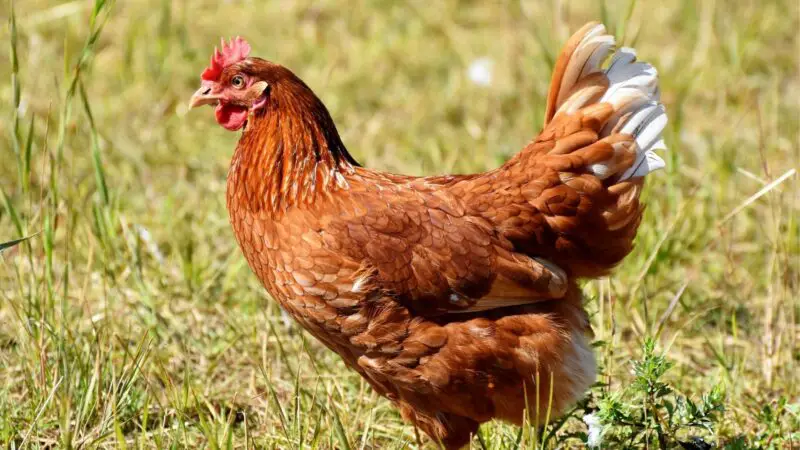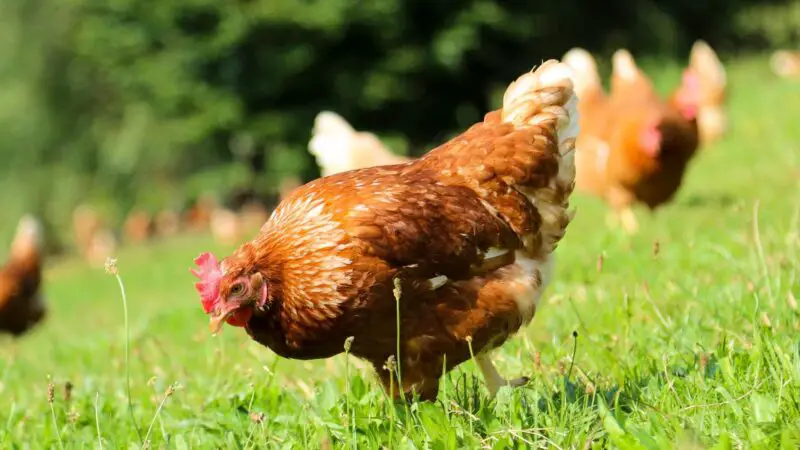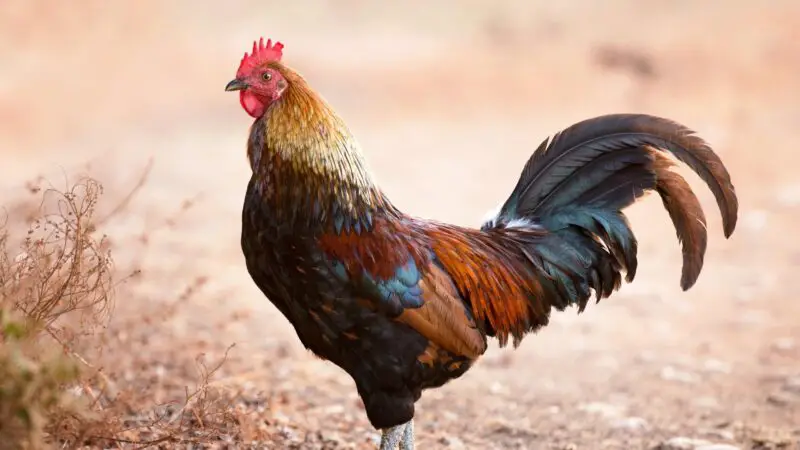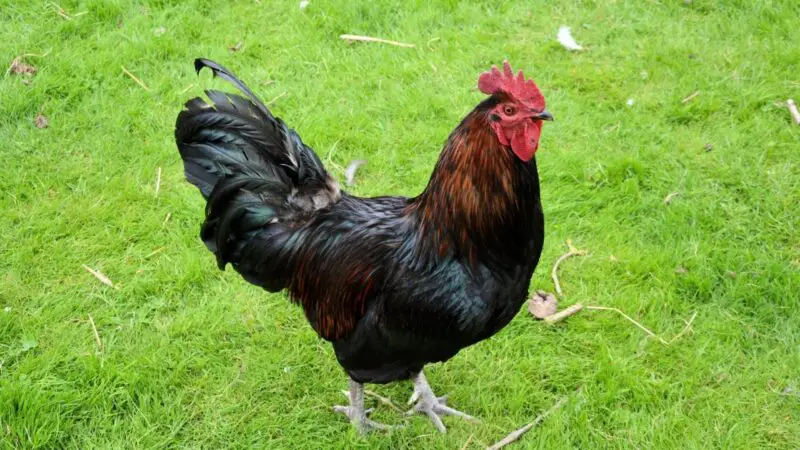Numerous animals have tails that are in different forms. When looking at chickens, have you ever wondered if they have a tail or not? It’s hard to tell because their bodies are covered with feathers.
When you have this thought, you’re on the right page, as you’ll find points for clarification.
Do chickens have tails? Chickens have tails as the tailbone is part of their skeletal system. To see their tails, you need to remove the feathers located at the tip of their bodies. In addition, roosters have tail feathers that are accompanied by sickle feathers. These long, curvy, and conspicuous feathers are exclusive among roosters.
This affirmation that chickens have tails spark curiosity. Why does a tail need to be kept under the feathers? One won’t be bothered by many questions when there’s an explanation.
To answer your query regarding the chicken’s tail, you have to dig deeper into its anatomy.
Anatomy of a Chicken

Skin and Feathers
Skin
The chicken’s body is covered by skin which has several vital roles. It deals with sensory input of pleasure, pain, heat, and cold. Also, it converts a certain compound into Vitamin D.
The skin of the chickens acts as insulation together with the feathers. Here are the different types of chicken skin:
- Feathered skin – You first see the feathers, but they grow in specific skin pathways and follicles.
- Scaled skin – This skin is similar to what existed in the dinosaur age, and it’s the coat of the chicken’s legs and feet. It’s also a form of protection for the legs.
- Combs and wattles – These skin types are considered the second sexual appendages. They come out when the chicken becomes sexually mature.
- Footpad – Located at the feet’s base, it’s understandable why it’s thicker, tougher, and more flexible than other skin types.
- Beak and Toenails – These parts are composed of hardened keratin, and they’re used as a weapon by chickens.
For additional information about chicken skin, the preen gland produces oily substances to keep the feathers lubricated and in good condition. It’s a uropygial gland that’s on the base of the chicken’s tail.
Feather
Feathers are vital for chickens because they can’t fly without them. They also warm the birds during the cold season and cool them down when the weather gets hot. Courtship and camouflage are also linked with feathers.
When chickens are one year old, they can molt their feathers in a year. The molting process will usually take 8 to 12 weeks, but some need more time.
The growth of new feathers begins in the follicles. The old is being pushed gradually until it’s molted and gives way to the new ones. At first, the chicken will appear like a porcupine with short quills that are sensitive to the touch.
The University of California had research on the growth of chicken feathers. Two theories were presented for better understanding. The first one is the timing of the gene activation that directs the skin cell whether it will remain as a skin cell or hair cell and sweat gland cell.
The second theory is that skin cell function is influenced by other cells that it mingles with and the surface where it grows. The researchers found out that the existence of hair follicles is derived from the cell’s traction and the pull in the skin structure.
All of the skin cells are initially identical. A mechanical behavior transforms them into follicles for growing feathers.
Bone, Legs, and Wings
There are strong muscles that bind the chicken’s wings to the sternum. Despite the selective breeding of these birds to create feature variations such as colors, shapes, and sizes, the skeletal and muscular systems remain unchanged. So, chickens still can’t fly too high.
Chicken legs are almost similar to human legs except for the hip bone that is connected with the backbone. Just like any other bird, they walk on their toes.
The connection of bone, legs, and wings of chicken is uncovered by a comparative study. To determine the strength of legs and wings, the characteristics of the bones should be taken into account.
They are shallow and filled with marrow. Bones are in irregular form just when you compare legs and wings. Therefore, the strength of the bones can’t be determined even with the moment of inertia.
Why Do Chickens Have Tail?

Chickens have a tail because they use it for balance when walking and flying.
What is a Chicken’s Tail Called?
A chicken’s tail is called pygostyle.
Why Does My Chicken Not Have a Tail?

Once the feathers are on the tail shed, you’ll think that your chicken doesn’t have a tail. This happens because chickens go through molting. It happens when old feathers need to be replaced with new ones.
Another reason is the response to low light that occurs in fall. It can last up to 7 to 8 weeks. However, the period varies according to breed or bird strain. So, it can be for 4 to 12 weeks.
Apart from natural shedding, there are other reasons why a chicken loses its feathers. Stress can cause it as well, and it’s a consequence of harsh environmental conditions, sanitation, predators, and in-fighting.
Why Do Chickens Pull Their Feathers Out?
Chickens don’t pull their feathers out. If it’s not molting or natural shedding of feathers, it’s because a chicken pecks another. It can happen when you mix birds of different sizes, colors, and types.
Overcrowding can also start, so make sure that each chicken is provided with enough space.
It’s crucial that you give the fowls enough food and water. Hunger can intensify their impulse to peck another chicken. You can use anti-pecking sprays like Rooster Booster Pick No More and Hemp Well Bird Hemp Oil for prevention. If the feathers are removed, the attacker continues pecking on the flesh. So, it draws out the blood, and this is called poultry cannibalism that needs to be stopped.
It can be a different case since barebacks are common among hens. You may think that they pull their feathers out because their skin is bare. It happens during the period of egg production. The energy that they use for new feathers is instead contained in laying eggs.
What Is Wry Tail in Chickens?
A wry tail in chickens is a tail that goes sideways. This defect can be compared to a crooked nose or finger of humans. It’s genetic, so you don’t want to raise a hen with this condition. It can also be caused by injury. Though this is not a serious condition, a fowl with a wry tail is not an ideal candidate for a poultry show.
What Does It Mean When a Hen’s Tail Is Down?
When a hen’s tail is down, there’s a case of egg-binding. It means that an egg gets stuck despite her effort to release it. Unfortunately, it can’t be controlled, but the owner should be attentive to the needs and welfare of the chicken to prevent it.
Obesity shouldn’t be stimulated within the flock and promote exercises instead. Nonetheless, your chickens should be given the right nutrition and a clean environment to live in. It’s also crucial to spay the hen from having an extra egg layer.
Do We Eat Chicken Tail?

The chicken tail skewer is common in Asia but not in other parts of the world like the US. Many like it because it’s juicy and flavorful. However, health considerations should not be taken for granted since this is high in fat. It may also be filled with hormones and bacteria that can affect human health negatively.
Frequently Asked Questions
How to Tell a Rooster From a Hen?
Roosters have long tail feathers or also known as hackle feathers and saddle feathers. Although hens have this feature, it’s shorter. The rooster’s comb is also larger than the hen. When it comes to wattle, the one that you can see on roosters hang longer than the hens.
Related: What’s the Difference Between a Hen and a Chicken? | Information and Facts
How Feathers Get Their Color?
The feathers of the chicken get their color because of primary and secondary color patterns. The primary pattern is the color of the whole body which is not shown in every feather.
On the other hand, the secondary pattern is the feather’s hue. It can be mottled, single or double lacing, and more. The combination and variation of colors are managed by E-locus genes.
You may find sheen on chicken feathers as it’s only how the structure reflects light. There’s also the case of dark-skinned chicken like Silkie. Both the skin and feather are black due to fibromatosis.
How Can You Tell if a Chick Is a Rooster or Hen?
Determining whether a chick is a rooster or hen depends on the breed. Generally, the feather will guide you. Chicks with longer wing feathers are females while males have longer tail feathers.
Summary
Chicken have tails that are covered with feathers. They have it for balance when walking and flying. If you notice, the longest feather of the chickens, despite the gender is on their tails. Thus, it’s the first thing that you will notice when they shed feathers. It’s also the part that allows you to easily identify roosters from hens.
